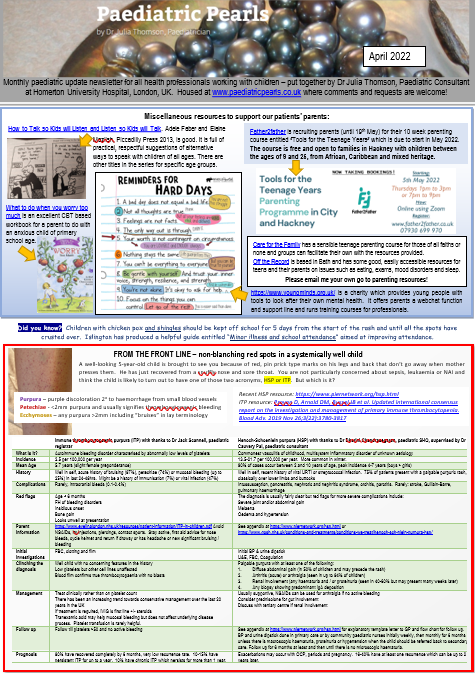MCV- Mean Corpuscular Volume. (with thanks to Dr Xanna Briscoe and Prof Irene Roberts)
A measure of the size of the red blood cells.
Raised MCV- macrocytosis– may occur with or without anaemia. Physiological macrocytosis in the absence of anaemia occurs in neonates, especially those with Down syndrome, and during pregnancy.
Macrocytic anaemia- may be secondary to nutritional deficiencies in B12 and Folate leading to ineffective or abnormal erythropoiesis. This is easily diagnosed using simple blood tests. Where deficiency is excluded bone marrow examination may be required to identify rare causes such as myelodysplasia or Fanconi anaemia.
There are several drugs that may lead to macrocytosis, some of which are commonly used in the paediatric population. These include several chemotherapeutic agents, antibiotics and antiviral medications. It is also seen in congenital heart disease, hypothyroidism and Down Syndrome.
Additional investigations- guided by the history. It is important to check a reticulocyte count if a macrocytic anaemia is discovered. Reticulocytes are immature erythrocytes- which are large, and indicate increased erythropoiesis. Chronic reticulocytosis may falsely elevate the MCV. The absence of a raised reticulocyte count in the presence of severe anaemia suggests an inability of the bone marrow to produce red cells, eg due to inherited or acquired red cell aplasia.
Kaferle, Joyce, and Cheryl E. Strzoda. “Evaluation of macrocytosis.” American family physician 79.3 (2009).
Microcytosis– small red blood cells. Typically seen in iron deficiency anaemia; in the paediatric population at different ages the cause differs. In younger children and toddlers lack of supplementation may lead to deficiency. This is a particular issue in those that drink large volumes of cows milk as a substitute for iron containing foods. The main differential diagnosis is beta- or alpha-thalassaemia trait. Measurement of serum ferritin is the most useful test to identify iron deficiency- this will be low in iron deficiency and normal in beta- or alpha-thalassaemia trait.
In adolescence the pubertal growth spurt, and menorrhagia may be a causative factor. Further investigation will aid in determining the causes of microcytic anaemia (see below).
W Owen Uprichard, James Uprichard. Investigating microcytic anaemia. BMJ 2013;346:f3154
As published in April 2017 Paediatric Pearls newsletter…..
| Increased MCV (macrocytosis) |
Decreased MCV (microcytosis) |
| Vitamin B12 DeficiencyFolic Acid DeficiencyAlcohol Abuse
Liver disease
Marrow aplasia
Myelofibrosis
Reticulocytosis
Hypothyroidism |
Iron Deficiency AnemiaThalassemiaHemoglobinopathy
Anemia of Chronic Disease
Sideroblastic Anemia
Chronic Renal Failure
Lead Poisoning |
Source: http://www.fpnotebook.com/HemeOnc/Lab/MnCrpsclrVlm.htm
MCV is expressed in femtoliters = 10^-15 liters
MCV cutoffs vary by age and by lab reference
MCV Normal Range:
- Newborn: 95 to 121 fl
- Ages 6 months to 2 years: 70 to 86 fl
- Ages 12 to 18 years
- Boys: 78 – 98
- Girls: 78 – 102
- Age over 18 years: 78 to 98 fl
MCV Cutoffs for Microcytic Anemia:
- Age 1-2 years: <77 fl (CDC)
- Age 3-5 years: <79 fl (CDC)
- Age 6-11 years: <80 fl (CDC)
- Age 12-15 years: <82 fl (CDC)
- Age >15 years: <85 fl (CDC)
- Recommended adult microcytic MCV cutoff varies
Some sources advocate MCV <78 and others <82
So, you’ve got the FBC back and it shows microcytic anaemia. How can you work out which of the above factors is causative?
If you only asked for FBC and the child is more than 6 months old, try this:
|
Anaemia of chronic disease |
Thal trait (alpha OR beta) |
Iron deficiency anaemia |
Thal trait + IDA |
Haemoglobinopathy |
| Hb |
↓ |
N / ↓ |
↓ / ↓↓ |
↓ / ↓↓ |
↓ or ↑ |
| MCV |
N / ↓ |
↓ / ↓↓ |
↓ / ↓↓ |
↓ / ↓↓ |
↓ or ↑ |
| MCH |
N / ↓ |
↓ / ↓↓ |
↓ / ↓↓ |
↓ / ↓↓ |
↓ or ↑ |
| RBC |
↓ |
N/↑ |
N / ↓ |
N / |
↓ or ↑ |
| RDW |
N |
N |
↑ |
↑ |
↓ or ↑ |
Therefore a child of 6 months or older with hypochromic, microcytic anaemia with an increased RDW has presumed iron deficiency. They could have thalassaemia trait as well….
If you asked for other tests or are at liberty to repeat the blood test, here are some suggested extra investigations and their interpretation:
| Investigation |
Iron deficiency anaemia |
Thalassaemia trait |
Sideroblastic anaemia |
Chronic disease |
| Ferritin |
decreased |
Normal |
increased |
Normal/increased |
| Iron |
Decreased |
Normal |
Increased |
Decreased |
| TIBC |
increased |
Increased |
Normal |
decreased |
| transferrin |
decreased |
normal |
Normal |
Decreased |
| Hb electropheresis |
normal |
Β thalassaemia- raised A2
α trait- normal |
normal |
normal |


